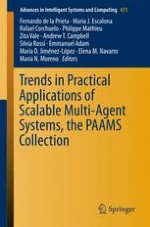PAAMS, the International Conference on Practical Applications of Agents and Multi-Agent Systems is an evolution of the International Workshop on Practical Applications of Agents and Multi-Agent Systems. PAAMS is an international yearly tribune to present, to discuss, and to disseminate the latest developments and the most important outcomes related to real-world applications. It provides a unique opportunity to bring multi-disciplinary experts, academics and practitioners together to exchange their experience in the development of Agents and Multi-Agent Systems.
This volume presents the papers that have been accepted for the 2016 in the special sessions: Agents Behaviours and Artificial Markets (ABAM); Advances on Demand Response and Renewable Energy Sources in Agent Based Smart Grids (ADRESS); Agents and Mobile Devices (AM); Agent Methodologies for Intelligent Robotics Applications (AMIRA); Learning, Agents and Formal Languages (LAFLang); Multi-Agent Systems and Ambient Intelligence (MASMAI); Web Mining and Recommender systems (WebMiRes). The volume also includes the paper accepted for the Doctoral Consortium in PAAMS 2016 and Collocated Events.
